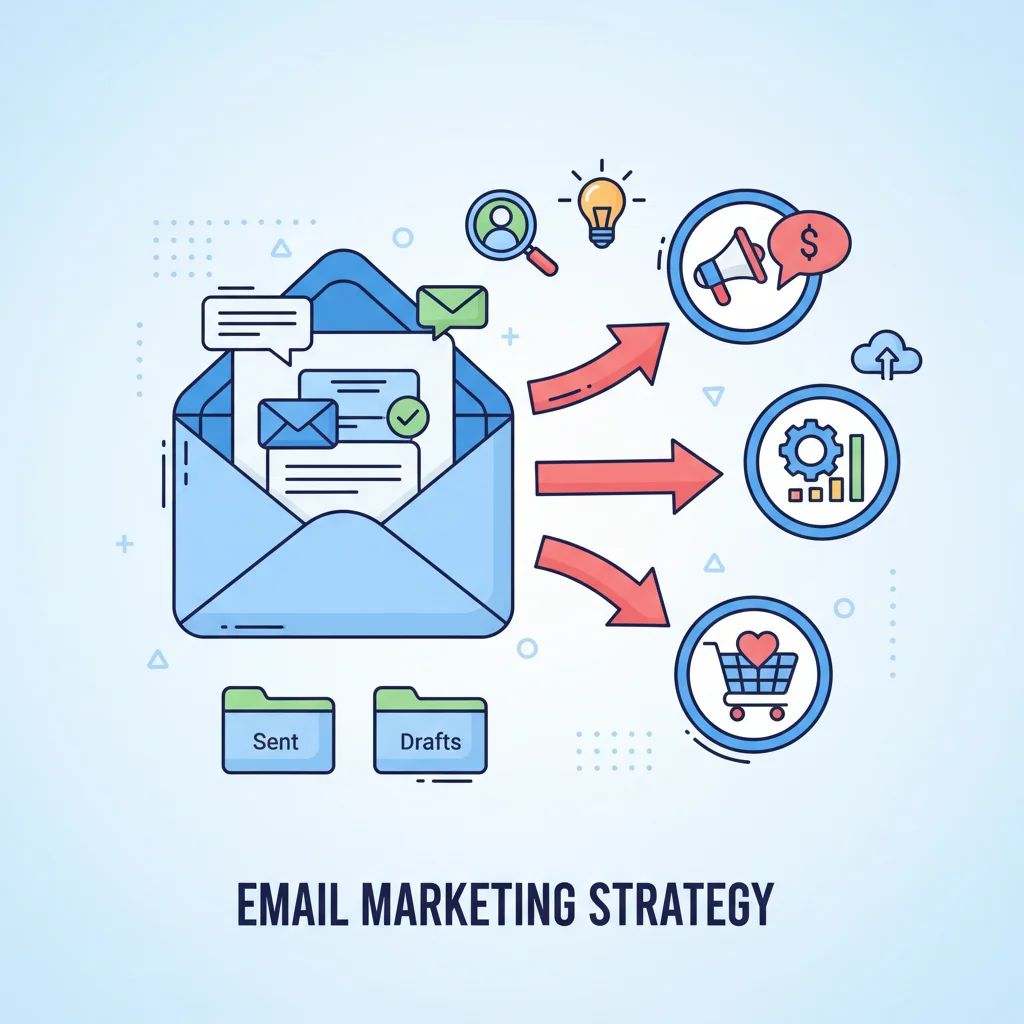Now Reading: 10 Common Email Marketing Mistakes That Are Killing Your Conversions
-
01
10 Common Email Marketing Mistakes That Are Killing Your Conversions
10 Common Email Marketing Mistakes That Are Killing Your Conversions

Are your email campaigns failing to generate the results you expected? Do you find yourself wondering why your open rates are dropping or why subscribers aren’t clicking through? The problem might not be your product or even your audience-it could be that you’re making some common email marketing mistakes without even realizing it.
Key Takeaways
What are the most common email marketing mistakes and how to avoid them? Here’s what you need to know:
- Poor subject lines that are generic, misleading, or overly promotional can kill your open rates. Keep them clear, concise (4-7 words works best), and personalized.
- Sending to unengaged subscribers damages your deliverability. Regularly clean your list and remove contacts who haven’t opened in 90+ days.
- Non-mobile-friendly designs frustrate the nearly 50% of people reading on phones. Use responsive templates with simple layouts and large tap targets.
- Too many CTAs confuse readers and reduce action. Focus on ONE primary goal per email.
- Lack of personalization makes emails feel generic. Segment your audience and tailor content based on behavior and preferences.
- Forgetting to proofread makes you look unprofessional. Always check links, promo codes, and spelling before hitting send.
The Subject Line Struggle
Let’s be honest-nobody’s opening your email if the subject line stinks.
This is where most email campaigns crash and burn before they even get a chance. I see it all the time: “Newsletter #45” or “May Update” sitting sadly in inboxes, ignored forever.
What goes wrong
The most common subject line mistakes I see:
- Being boring as heck: “Monthly Newsletter” might be accurate, but it’s about as exciting as watching paint dry
- Going WAY too promotional: “BUY NOW!!! HUGE SALE!!!” (hello, spam folder my old friend)
- Writing novels: If your subject line gets cut off on mobile, you’ve already lost
- Clickbait that doesn’t deliver: This might get opens once, but you’ll lose trust fast
Data shows that subject lines with 4-7 words perform best, with anything longer seeing an immediate drop in engagement[5]. On mobile devices, you’ve got about 41 characters before getting cut off-roughly the length of a seven-word subject line[6].
How to fix it
Instead of generic snooze-fests, try subject lines that:
- Create curiosity: “This weird trick doubled our open rates”
- Offer clear value: “5 templates to save you 3 hours this week”
- Use personalization: “[First name], your cart is about to expire”
- Ask engaging questions: “What would you do with an extra $1,000?”
Remember that your subject line is making a promise that your email content needs to keep. No tricks!
Useful Articles:
The Dirty List Disaster
Sending to a messy, unengaged list is like throwing a party and inviting people who moved away years ago. Nobody shows up, and you look kinda desperate.
What goes wrong
The biggest list management mistakes include:
- Never cleaning your list: Those 10,000 subscribers look impressive until you realize 8,000 haven’t opened an email in a year
- Buying email lists: Just don’t. Seriously. These people don’t know you and didn’t ask to hear from you
- Ignoring engagement metrics: Continuing to email people who never open your messages hurts your sender reputation
- Not segmenting: Blasting the same message to everyone regardless of their interests or behavior
When you send to unengaged subscribers, email providers notice those poor engagement rates and start sending more of your emails to spam-even for people who DO want to hear from you[2].
How to fix it
- Regularly remove subscribers who haven’t engaged in 90+ days (or try a re-engagement campaign first)
- Segment your list based on behavior, purchase history, or interests
- Make it easy to unsubscribe-better to lose them cleanly than have them mark you as spam
- Focus on list quality over quantity-1,000 engaged subscribers beat 10,000 zombies any day
The Mobile Mess-Up
Almost half of all emails are opened on mobile devices, but some marketers still design like it’s 2005[4].
What goes wrong
Common mobile design mistakes include:
- Tiny, unreadable text that requires the pinch-and-zoom dance
- Multi-column layouts that break on small screens
- Huge images that take forever to load on mobile data
- Microscopic buttons that nobody can tap accurately
One German retailer, Witt Weiden, discovered their newsletters weren’t optimized for mobile-and it was killing their performance. After switching to mobile-friendly designs, their open rates jumped by 8% and click rates increased by 4%[4].
How to fix it
- Use responsive email templates that automatically adjust to screen size
- Stick with single-column layouts for mobile readability
- Make buttons at least 44×44 pixels (about the size of an adult fingertip)
- Test your emails on actual mobile devices before sending
- Keep your designs simple and focused
Useful Articles:
The CTA Chaos
I’ve seen emails with so many calls-to-action they look like a carnival midway. “Step right up! Click here! No wait, click there! Actually, click EVERYWHERE!”
What goes wrong
The biggest CTA mistakes are:
- Including too many different actions in one email (read blog, shop now, follow social, download guide…)
- Unclear button text like “Click Here” instead of specific actions
- Burying your CTA where nobody can find it
- Mismatched expectations between what the CTA promises and where it actually leads
When you give people too many options, they often choose none at all[5]. Decision paralysis is real!
How to fix it
- Focus on ONE primary goal per email
- Make your main CTA button stand out visually
- Use action-oriented, specific button text (“Reserve My Spot” not “Click Here”)
- Ensure your CTA delivers exactly what it promises
- If you must include secondary CTAs, make them visually less prominent
The Personalization Problem
“Dear Valued Customer” might as well say “I couldn’t be bothered to learn your name.”
What goes wrong
The most cringe-worthy personalization mistakes:
- No personalization at all: Generic messages that could be sent to anyone
- Failed personalization: “Hi {FIRST_NAME}!” (we’ve all gotten these)
- Shallow personalization: Just adding a name but keeping everything else generic
- Sending the same content to different segments: What works for new subscribers won’t work for loyal customers
How to fix it
- Always test your personalization tags before sending
- Go beyond just using names-personalize based on:
- Past purchases
- Browsing behavior
- Geographic location
- Signup source
- Engagement level
- Create different email content for different segments of your audience
- Use behavioral triggers for timely, relevant emails (abandoned cart, product viewed, etc.)
Useful Articles:
The Proofreading Pitfall
Nothing says “unprofessional” like an email full of typos, broken links, or missing promo codes.
What goes wrong
Common proofreading failures include:
- Broken or incorrect links that lead nowhere or to the wrong page
- Missing promo codes that were promised in the subject line
- Typos and grammar errors that make you look sloppy
- Placeholder text that was never replaced (“INSERT PRICE HERE”)
- Wrong dates or information about events or promotions
These mistakes aren’t just embarrassing-they can cost you real money. If customers can’t use your promo code or access your sale, they’re not buying[3].
How to fix it
- Always have a second pair of eyes review your emails
- Test every single link before sending
- Send test emails to yourself and click through the entire user journey
- Use a pre-send checklist to verify all elements (links, dates, promo codes, etc.)
- When mistakes happen (and they will), send a correction quickly with a sincere apology
The Design Disaster
Some emails look like they were designed by a committee of clowns on energy drinks.
What goes wrong
The worst design offenses include:
- Visual clutter with too many images, fonts, and colors
- Huge image files that take forever to load
- No clear visual hierarchy so readers don’t know where to look
- Walls of text with no breaks or formatting
- Designs that break in different email clients
How to fix it
- Embrace white space-it makes your content more readable
- Stick to 1-2 fonts and a consistent color scheme
- Use clear headers and short paragraphs
- Include alt text for images (many users have images turned off)
- Test your emails across multiple email clients and devices
The Frequency Fiasco
Too many emails? Unsubscribe. Too few? They forget who you are. Finding the right balance is tricky.
What goes wrong
Common frequency mistakes include:
- Email bombing: Sending multiple messages in a short time period
- Inconsistent sending: Disappearing for months, then suddenly flooding inboxes
- Poor timing: Sending business emails on weekends or consumer emails during work hours
- Ignoring time zones: Sending at 3 AM local time for half your list
How to fix it
- Set clear expectations about email frequency during signup
- Maintain a consistent sending schedule
- Allow subscribers to choose their preferred frequency
- Test different sending times to find what works for your audience
- Consider time zones when scheduling global campaigns
The Legal Landmine
Nothing kills an email program faster than legal troubles.
What goes wrong
The most dangerous legal mistakes:
- No clear unsubscribe option: Making it difficult or impossible to opt out
- Missing physical address: Required by CAN-SPAM and similar laws
- Misleading subject lines: Promising something the email doesn’t deliver
- No consent records: Being unable to prove someone opted in
- Ignoring privacy laws: Not complying with GDPR, CCPA, or other regulations
How to fix it
- Include a clear, one-click unsubscribe link in every email
- Always include your physical business address in the footer
- Keep records of how and when people subscribed
- Use double opt-in to confirm subscription intent
- Stay current on email marketing laws in regions where you have subscribers
The Testing Tragedy
Not testing your emails is like jumping out of a plane without checking your parachute. Might work out, probably won’t.
What goes wrong
The biggest testing failures:
- No testing at all: Just hitting send and hoping for the best
- Testing too many variables at once: Making it impossible to know what worked
- Testing on a sample too small: Drawing conclusions from insufficient data
- Ignoring test results: Continuing what doesn’t work because “that’s how we’ve always done it”
How to fix it
- A/B test one element at a time (subject lines, send times, CTA language, etc.)
- Use a large enough sample size to get statistically significant results
- Apply what you learn to future campaigns
- Test across different devices and email clients
- Consider testing:
- Subject lines
- Preheader text
- Send time/day
- Email length
- CTA placement and wording
Email marketing isn’t rocket science, but it does require attention to detail and a willingness to learn from mistakes. By avoiding these common email marketing mistakes, you’ll stand out in increasingly crowded inboxes and build stronger relationships with your subscribers. Start by fixing one issue at a time, measure the results, and keep improving. Your open rates (and your bottom line) will thank you.




















